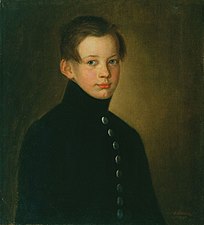Otto Friedrich Theodor von Möller
Otto Friedrich Theodor von Möller | |
|---|---|
| Фёдор Антонович Моллер | |
 Self-portrait (late 1840s) | |
| Born | 30 May 1812 |
| Died | 21 July 1874 (aged 62) |
| Alma mater | Imperial Academy of Arts (1838) |
| Known for | Painting |
| Notable work |
|
| Awards | |
| Elected | Member Academy of Arts (1840) Professor by rank (1857) |
Otto Friedrich Theodor von Möller, russified as Fyodor Antonovich Moller (Russian: Фёдор Анто́нович Мо́ллер; 30 May 1812 – 2 August 1874) was a Russian Academic painter of Baltic-German ancestry.
Biography
[edit]Born in Kronstadt, Saint Petersburg, he was the son of Anton Berend Otto von Moller, also known as Anton Vasilievich Moller, a naval officer who later became Secretary of the Navy (1828–1836).[1] At the age of five, he was enrolled at the cadet school, where he remained until he was 14, then served in the Semyonovsky Regiment. After being wounded in the Polish November Uprising, he took up drawing during his convalescence and decided to attend classes at the Imperial Academy of Fine Arts.[2]
Once there, he became a favorite student of Karl Briullov.[1] He first exhibited in 1832 with a scene of the Battle of Ostrołęka. In 1835, he was awarded a gold medal for painting and resigned from the army. He received another gold medal in 1837.
After graduating in 1838, he went to Italy to complete his studies. He continued to send paintings home and, in 1840, was named "Academician" for his work "The Kiss".[1] While there, he also became a close friend of Nikolai Gogol and painted him several times, which portraits are among his best-known works.
After a brief stay in Russia in 1847, he returned to Rome, where he met Johann Friedrich Overbeck and the Nazarene movement. His work in that style, "Sermon of the Apostle John on the Island of Patmos", led to his becoming "Professor of Historical Painting" when he returned to Russia in 1856. That same year, he married Dorothea von Güldenstubbe, who was only sixteen.[2]
Back in Saint Petersburg, he devoted himself to teaching and managing a pension fund for artists at the Imperial Society for the Encouragement of the Arts.[2] His works include a series of paintings of Alexander Nevsky for the Grand Kremlin Palace and murals for Saint Isaac's Cathedral.[1]
He was suddenly taken ill while working on the Crucifixion in the village of Võnnu (Wendau). He died of pneumonia at the family estate on the island of Saaremaa.[2]
Gallery
[edit]-
John's Sermon on Patmos
-
Alexandr Nevskiy and papal legates
-
Carrying the cross
-
Family of Ivan Kruglikov
-
Sleeping girl
-
Portrait of a boy
-
Portrait of Princess Louise Golitsyna
-
Portrait of Nikolai Gogol
-
Portrait of Fyodor Bruni
-
Bride
(Girl with a ring)
References
[edit]- ^ a b c d Brief biography @ Russian Paintings.
- ^ a b c d Brief biography @ RusArtNet.
Further reading
[edit]- Markina, Lyudmila A. (2002). Живописец Фёдор Моллер (in Russian). Moscow: Pamyatniki istoricheskoy mysli. ISBN 5-88451-118-3. OCLC 51755818.
External links
[edit]- Markina, Lyudmila A. (2012). "«Художник с блестящим талантом и хорошими средствами…»". Tretyakov Gallery Magazine (in Russian). No. 37. pp. 64–77.
- Markina, Lyudmila A. (February 25, 2007). "Самый известный портрет писателя Николая Гоголя работы художника Фёдора Моллера". Собрание Третьяковки (Interview) (in Russian). Interviewed by Xenia Basilashvili, Xenia Larina. Moscow: Echo of Moscow. Archived from the original on October 1, 2017.
- Gogol's portrait @ Portraits of Russian Writers
- Imperial Academy of Arts alumni
- Awarded with a large gold medal of the Academy of Arts
- Members of the Imperial Academy of Arts
- Academic staff of the Imperial Academy of Arts
- 1812 births
- 1874 deaths
- People from Kronstadt
- People from Petergofsky Uyezd
- Baltic-German people from the Russian Empire
- 19th-century painters from the Russian Empire
- Russian male painters
- Russian portrait painters
- Religious artists
- Russian muralists
- Deaths from pneumonia in Estonia
- 19th-century male artists from the Russian Empire











